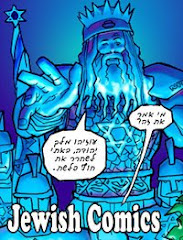For more than 2,500 years, Jews have been telling their faith's sacred stories, in written words on parchment and the page, and through the oral tradition of rabbinical debate.
Now they're trying something new: a graphic novel.
The Jewish Publication Society, a venerable group that is the closest thing to an official press for all the religion's denominations, is turning to a very modern way to reach young Jews. "Megillat Esther" is a graphic novel - an extended, black-and-white comic book - based on the holiday of Purim, and probably rated PG-13 for a few borderline racy drawings.
"We all understood that it was a way to reach a much younger generation," says Ellen Frankel, CEO and editor in chief of this Philadelphia-based publisher. "Even though it is a stretch for JPS, it is right on point because it's Bible commentary."
This Jewish foray into the world of graphic novels is just the latest example of believers creating alternative forms of religious messages in print.
...
Nor did the Jewish Publication Society want to limit itself to already committed observant Jews with "Megillat Esther."
The story, about a Jewish maiden in ancient Persia who becomes a queen and saves her people from genocide, is told both in the original Hebrew and English, although some pages are wordless. Other pages have numbers at the bottom indicating rabbinical commentaries from books such as the Talmud, and there is a detailed, scholarly bibliography at the back.
At the same time, it is a typical graphic novel: Female characters tend to be voluptuous, and the pages are peppered with self-deprecating wisecracks. Near the end of the story, one small character says, "The whole thing seemed a bit overdrawn to me."
The author, JT Waldman, spent seven years working on the book, including 18 months in a Jerusalem yeshiva learning Hebrew and studying the Bible and commentary.
"First came the love of comics and that way of storytelling," says Waldman, 29, who is now studying computer graphics in Canada. "The Bible and Jewish angle didn't come until I graduated from university and was trying to flesh out my Jewish identity. I wanted to merge my new interest in Judaism with my more established language and vernacular of illustrating comics."
Turned down by religious and commercial publishers, he was about to self-publish the book when the offer came from the Jewish Publication Society.
"I looked at it and thought it was amazing, but I thought that JPS would never agree to publish it," Frankel says, even though it includes every word of the Hebrew scroll. She was uncertain how the board of her 118-year-old press would respond.
"Before the meeting, I took a number of Post-its and flagged the pages that were the most outrageous," she says, but to her surprise, "They all loved it. Their response was: 'It's time.' "
In the introduction, Rabbi Moshe Silverschein, Waldman's teacher at Hebrew Union College in Jerusalem, calls the book an "expanded biblical narrative" and "not just a simple comic book."
Review: People Who Eat Darkness, by Richard Lloyd Parry
-
*People Who Eat Darkness: The True Story of a Young Woman Who Vanished from
the Streets of Tokyo- and the Evil that Swallowed Her Up*, by Richard Lloyd
...
3 years ago







No comments:
Post a Comment